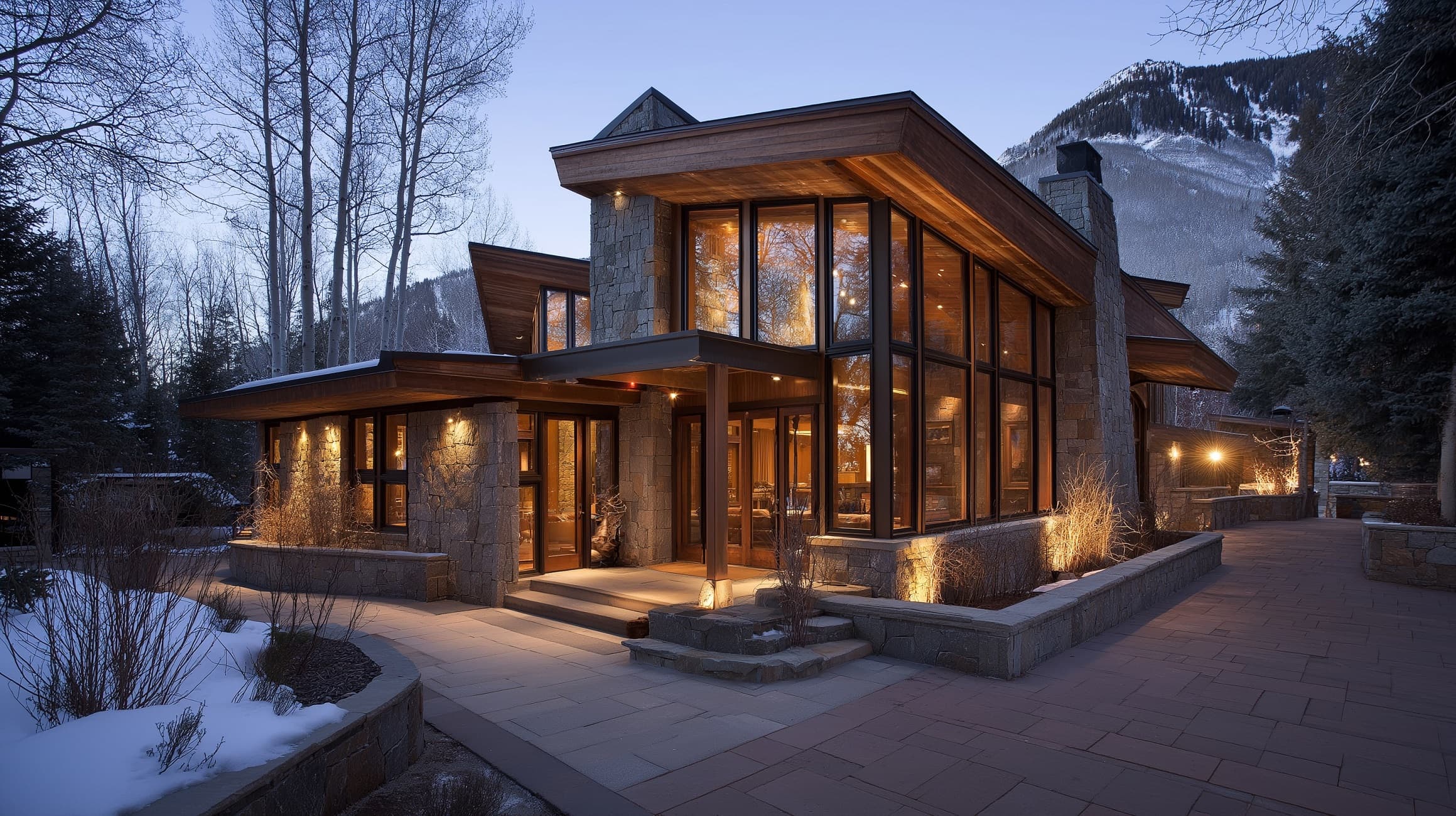Aspen’s real estate market is entering 2025 from a position of unprecedented growth and enduring demand. Over the past few years, this exclusive mountain enclave in Colorado saw record-breaking sales driven by ultra-wealthy buyers, pandemic-era relocations, and a chronic shortage of supply. As the market normalizes from the historic frenzy of 2021 (when transaction counts hit roughly 1,500, far above the ~900 per year long-term average), attention is turning to what’s next. In this comprehensive report, we explore Aspen’s residential and commercial real estate trends for 2025 and beyond – covering market forecasts, pricing, inventory, new developments, luxury buyer behavior, investment returns, and key factors like interest rates, tourism, remote work, and local policies. Current data from 2024–2025 and expert insights provide a grounded outlook through 2027 on Aspen’s resilient yet evolving property market.
Market Trends and 2025–2027 Forecast
After two years of extreme post-pandemic growth, Aspen’s real estate market is stabilizing at high levels. Total sales volume in Aspen/Pitkin County jumped from about $3.1 billion in 2023 to $3.8 billion in 2024, indicating robust activity even if off the peaks of 2021. Unit sales in Aspen ticked up ~3% in 2024 (180 sales vs 174 in 2023) while dollar volume dipped ~3%, suggesting slightly softer pricing or fewer mega-deals. Snowmass Village, Aspen’s neighboring resort town, saw even stronger momentum – unit sales up 16% in 2024 – thanks to new development inventory fueling demand. Entering 2025, the consensus is that the market will cool modestly from its feverish pace. Local analyst Randy Gold forecasts that overall 2025 sales will decline from 2024 levels, with an expected 650–800 transactions totaling $2.8–$3.3 billion in volume. Much of this slowdown is anticipated in the second half of 2025 (H2 2025), where sales activity could fall 20–40% compared to the previous year. In short, 2025 should still be a “good year but down compared to 2024,” with a noticeable slowing by late 2025.
Looking further ahead, industry experts remain bullish on Aspen’s long-term trajectory. Nationally, the housing outlook is expected to improve through 2026 as interest rates ease: the NAR’s chief economist projects U.S. home sales to rise ~9% in 2025 and 13% in 2026, with 30-year mortgage rates trending down to ~6% by 2026. Aspen’s market tends to be insulated but not immune to macro trends. Any short-term dip is likely to be followed by a quick rebound, given Aspen’s unique appeal. Longtime brokers liken Aspen real estate to a “blue-chip” asset that holds value and appreciates over time, even acting as a hedge in volatile times. “I wouldn’t bet against Aspen Snowmass long-term,” says one local expert, noting the area’s unparalleled lifestyle and proven resilience. By 2026–2027, assuming the broader economy stabilizes, Aspen’s property values are expected to resume a steady upward climb, albeit at a more measured pace than the explosive gains of 2020–2022. One predictive model foresees Aspen home prices cumulatively rising around 28% over the next 10 years, reflective of continued long-term appreciation (though annual results will vary). Overall, the 2025–2027 period is viewed as a normalization phase – a chance for the market to catch its breath – before potentially entering another growth cycle fueled by high-net-worth demand and limited supply.
Pricing Data and Appreciation Rates
Home prices in Aspen remain near record highs after the pandemic-era surge. In 2024, average pricing in Pitkin County jumped 24% year-over-year, bringing the average sale price to about $13.3 million. Aspen’s single-family homes saw tremendous price gains: the average Aspen house sold for $21 million in 2024 (median ~$16.75 million), with price-per-square-foot (PSF) averaging $3,300 – up from ~$2,900 prior, and even hitting $4,000+ per sq.ft. in elite neighborhoods like West Aspen and the West End. For perspective, 40% of Aspen’s active listings now ask over $4,000 per sq.ft., a threshold that only a few trophy properties achieved pre-2020. Condo prices have also climbed: the median Aspen condo price rose ~5% in 2024 to about $2.85 million, with 89 condo sales topping $2,000/sf in 2024. By early 2025, overall median home sale prices (all property types) hovered around $3.3 million, up 9.1% from a year prior rocket.com, according to Rocket Homes data. Even formerly “affordable” segments have seen appreciation – for instance, the Smuggler area remains relatively lower-priced for Aspen, yet values there have risen alongside the market.
At the ultra-high end, Aspen’s luxury real estate has redefined price ceilings. There were 5 home sales over $50 million in 2024, and one in every three home sales in Aspen now exceeds $20 million avantgardeaspen.com. In 2024 alone, Aspen recorded 11 sales above $30 million, including a record-shattering $108 million estate transaction at ~$4,820 per sq.ft.. The highest known price per square foot achieved was an astonishing $8,215/sf for a $43 million penthouse (Monarch on the Park), roughly double the pre-pandemic peak rate (in 2019, the top sale was $23M at ~$3,018/sf). As veteran broker Tim Estin notes, “Prices have increased by 2.5 to 3 times since COVID-19…there is just not enough supply to meet demand”. Indeed, after a slight correction in 2022 (Aspen’s median home price dipped ~14% that year), values have not only rebounded but soared to new heights. Luxury appreciation is being driven by intense demand for premium properties (particularly among wealthy buyers fleeing cities or seeking remote-work retreats) and a “nothing comparable” scarcity that lets sellers command top dollar. Even as the market cools slightly in 2025, most experts expect prices to hold near current levels or notch modest gains in the next couple years. Forecasts for 2025 call for values to be stable to up a few percent in most Aspen/Snowmass segments, with any price softening likely confined to over-supplied pockets or outdated inventory.
Inventory Levels and Housing Supply Constraints
Despite sky-high prices, inventory in Aspen remains very tight, a major factor bolstering the market. As of January 2025, Aspen had only 174 active residential listings – historically low supply – even after a slight 4% increase in inventory from the prior year. By May 2025, listings had risen further to around 258 homes on the market (a 5.7% monthly increase), reflecting a gradual build-up of supply. This uptick has started to shift Aspen’s housing conditions toward a more balanced or even buyer-leaning market relative to the frenzy of 2021–22 rocket.com. At the same time, demand has also cooled a bit, so properties are spending longer on market and buyers have more choices than a year ago rocket.com. Still, in absolute terms, housing supply remains far below long-term norms – Aspen’s for-sale inventory is a fraction of what it was pre-pandemic, and Snowmass likewise has constrained availability. Both Aspen and Snowmass ended 2024 with only “slight increases” in inventory, which “remains historically low,” according to Estin’s market report. In many price tiers and neighborhoods, bidding wars have given way to cautious negotiation, but sellers continue to hold considerable leverage due to the scarcity of quality properties.
A key reason for limited inventory is Aspen’s severe development constraints. The region faces a “land scarcity” problem – there are virtually no vacant land parcels left in prime areas like Aspen or Snowmass. Aspen’s city regulations heavily restrict new construction: The municipal code now caps residential building size to 9,250 sq.ft. (or 8,750 sq.ft. within the urban growth boundary), with a new tiered review process that makes large homes (over ~5,750 sq.ft.) very difficult to approve. Basements larger than 1,000 sq.ft. are no longer allowed (down from 4,000 sq.ft. before). On top of that, only 6–8 demolition permits are granted per year in the city of Aspen (via a lottery), plus a couple extra for longtime locals. All available 2025 demo permits have already been allocated, meaning developers who hoped to tear down and replace old structures must wait years. Since 2019, a total of only 32 demo permits were issued, and fewer than 10 actual demolitions have occurred – many permits were simply held for potential projects that never commenced. This bottleneck in redevelopment forces owners and builders toward renovations instead. In fact, it’s often easier and faster to do a “gut remodel” (keeping some portion of the structure) than to pursue a new build in Aspen’s regulatory environment.
Snowmass Village, while having more open space historically, is also running out of room. Nearly all of Snowmass’s Base Village land is now spoken for – once the final buildings under construction are completed by 2027, “there won’t be land left in Base Village to develop,” according to developers. Snowmass had 142 residential listings in 2024, but 89 of those were in one project (the Stratos condo development), underscoring how few independent listings exist outside new projects. Homes under $5 million in Snowmass are now virtually nonexistent, as the remaining inventory skews to luxury tiers. Meanwhile, Aspen’s entry-level market has all but vanished – even older condos routinely trade above $1,500–$2,000/sf, and single-family homes under $5–6 million are extremely scarce (often tear-downs if they do appear). Land prices have correspondingly skyrocketed: total land sales in Aspen fell to $253 million in 2024 simply because so few parcels remain, and the highest vacant lot sale was $35 million. Builders have pivoted to purchasing older homes for renovation or expansion; as one report notes, “buyers are turning toward remodels, additions, and demo/rebuild projects” given the lack of open land.
In short, Aspen’s supply constraints are structural and long-term. Strict growth controls, high construction costs (estimated $1,500/sf hard costs, $2,000–$4,000/sf all-in for luxury builds), and community resistance to over-development will continue to limit new housing inventory. Even when market demand ebbs, owners often hold onto Aspen properties as generational assets, so voluntary selling is low. This dynamic underpins Aspen’s high price floor – values are “a function of inventory and supply, and there just isn’t enough to meet demand,” as Estin observed. Going forward, 2025–2027 is likely to see only marginal relief in inventory (perhaps via a few new condo projects and homeowners deciding to cash out at peak prices), but no significant glut. By 2027, any short-term listings boost from slower sales could be absorbed once the market accelerates again.
New Residential and Commercial Developments
Despite Aspen’s building challenges, a number of notable development projects are underway that will shape the market’s future supply – particularly in Snowmass Village and Aspen’s downtown/hotel sector:
- Snowmass Base Village – Final Phase: Snowmass has been engaged in a decades-long redevelopment of its base area, culminating in a $1 billion Base Village project featuring luxury condos, hotels, shops, and amenities. The final residential complex, called “Stratos,” is a two-building, 89-unit luxury condominium project slated for completion in 2027. Sales for Stratos launched in Jan 2025 and saw frenzied buyer interest – within weeks, over 75% of the units went under contract (only ~21 of 89 units remained available by early 2025). Prices in Stratos started around $2.9M for smaller units and range up to $30M for penthouses. This project, along with the recently finished Cirque building (part of the Viceroy hotel, whose condos sold out in two weeks at ~$2,700/sf) businessinsider.com, is elevating Snowmass Village’s profile and pricing to near-Aspen levels. In fact, the average Snowmass condo sale price hit $3.8M in 2024 – matching Aspen’s condo average, and new Snowmass units have commanded $1,800–$2,500 per sq.ft. Once Stratos is complete in 2027, Base Village will be fully built-out, meaning Snowmass’s growth will largely shift to resales (likely at even higher prices, given no new inventory). The town that was once Aspen’s “little sibling” is coming into its own as a luxury destination businessinsider.com.
- Aspen Lift 1A Area – Luxury Hotels/Residences: A major development push is focused at the base of Aspen Mountain’s western side (Lift 1A corridor). Two long-awaited projects here are the Aman Aspen Resort (often called Gorsuch Haus/Aman) and the Lift One Lodge, which together promise new hotel rooms, fractional residences, and public amenities (a ski museum and skier services). After years of delays, these projects made progress in 2024: Lift One Lodge was in building permit review with expected permit issuance by early 2025, and the Aman/Gorsuch project was slated to submit permits by late 2024. The Aspen city Community Development Director indicated that initial construction work on Lift One Lodge could begin by summer 2025 (pending coordination with Aspen Ski Co). If these ultra-luxury hotels proceed on schedule, they may open around 2026–2027, adding high-end lodging and branded residences (Aman’s brand is expected to fetch record prices per square foot). This development will also activate a long-dormant slope-side area, effectively expanding Aspen’s core with new dining, retail and public space around a new Lift 1A and ski museum. The economic impact of Aman’s entry is expected to be significant, as it cements Aspen’s status among global luxury resort markets.
- New Hotels Downtown: In Aspen’s commercial core, two boutique hotels recently joined the lodging inventory. The MOLLIE Aspen, a 68-room luxury boutique hotel developed by local firm HayMax, opened in December 2023 to much fanfare. With Japanese-Scandinavian inspired design and a prime location by Paepcke Park, MOLLIE has quickly become one of Aspen’s chic new stays (even winning “Best Hotel” in a 2024 local awards). Hot on its heels, the White Elephant Aspen – a renowned Nantucket-based hotel brand – is opening its first western outpost in Aspen in late 2025, adding 54 guest rooms to Aspen’s lodging supply. The White Elephant (at 110 W. Main St.) promises a blend of mountain aesthetic with modern luxury, and local tourism officials welcomed the addition of “54 new guest rooms to Aspen’s lodging inventory” at its groundbreaking. These new hotels broaden Aspen’s capacity for visitors (which could indirectly support more short-term rental regulation, as the city prefers tourists stay in hotels). They also highlight investor confidence in Aspen’s tourism future.
- Other Developments: Several smaller projects and infrastructure upgrades are also notable. In Snowmass, luxury residential enclaves like Aura and Cirque (high-end ski-in/out residences) recently saw sales over $10M each, indicating new ultra-luxury homes outside Aspen proper. Aspen’s ultra-luxury spec home market continues as well, with a few large new builds hitting the market each year despite the regulations (often trading off-market for $30M+). On the horizon, the Aspen/Pitkin County Airport modernization will be a significant infrastructure project: Plans call for a new airport terminal by 2027–2028 and a runway realignment, requiring a full runway closure in summer/fall 2027. This $500M+ project, while not a real estate development per se, is expected to improve Aspen’s accessibility for larger aircraft and enhance the visitor experience long-term. During the closure months in 2027, there could be a temporary tourism dip (some travelers may opt for easier-to-access destinations, or stay in Snowmass instead), but the investment signals a “long-term commitment to Aspen’s future as a premier global destination.” In summary, new developments in Aspen and Snowmass are skewed toward the high end – luxury condos, hotels, and amenities – and while they will add some inventory, they will also raise the bar (and prices) for the market in coming years.
Luxury Real Estate Trends and High-Net-Worth Buyers
The Aspen market is fundamentally driven by ultra-high-net-worth (UHNW) buyers, and recent trends show this influence only growing. Aspen has become a magnet for billionaires and global elites seeking both a lifestyle and an investment. According to Forbes data, an estimated 100 to 125 billionaires now own homes in Aspen, putting it nearly on par with New York City in terms of billionaire real estate density. These buyers have reshaped Aspen’s sales distribution – as noted, fully one-third of Aspen home sales exceed $20M today avantgardeaspen.com, whereas such sales were rarities a decade ago. The entry of this elite segment has pushed Aspen’s luxury pricing into the stratosphere, with multiple $50M+ deals in a single year (unheard of in most markets). Many high-net-worth individuals (tech entrepreneurs, hedge fund managers, celebrities, foreign investors) view Aspen property as a trophy asset and safe haven. During the pandemic, this effect was amplified: “People leaving urban areas, and the ability to live and work remotely” led to a huge demand influx, doubling or tripling prices since 2019. Aspen’s appeal as a remote-work locale – offering natural beauty, privacy, and world-class amenities – means wealthy buyers now often purchase with the intent to spend extended periods or even primary residency in Aspen rather than just short vacations.
Luxury buyer behavior in Aspen emphasizes exclusivity, amenities, and long-term value. These buyers are typically cash buyers or make large down payments, so they are less sensitive to interest rate swings. Instead, their activity correlates more with financial markets and wealth creation. When stock markets or the economy wobble, Aspen can see a brief pullback in high-end sales as buyers become cautious. However, there are usually a few “safe haven” seekers who buy in Aspen even during downturns, believing in its enduring value. For example, despite a bear market in 2022, Aspen still notched record sales. By 2023–2024, as the economy normalized, the billionaire cohort dove back in, grabbing rare offerings (e.g. a $76M Aspen estate sale in early 2023 and the $108M sale in 2024). Off-market transactions have also grown – many high-profile deals never hit MLS, as buyers and sellers quietly trade among the ultra-rich. In 2024, Aspen saw multiple off-market sales above $30M that significantly “pushed the market upward” in terms of comps. This trend means official stats might even understate the true price appreciation at the top end.
Luxury tastes are also evolving. Buyers now expect turnkey, modern designs with wellness features and extensive amenities. “Modern, high-end condos that Aspen’s zoning doesn’t allow in town” have been built in Snowmass, attracting buyers who value new construction. Top neighborhoods like Red Mountain, Owl Creek, and the downtown core remain perennially desirable, but even traditionally “lesser” areas (like West Aspen or Snowmass) have seen luxury homes soar in value as the wealthy broaden their search for space and privacy. Many UHNW owners collect multiple Aspen properties – one expansive estate plus a pied-à-terre downtown, for instance. Short-term rental restrictions in Aspen (enacted in 2022) have not deterred these buyers much, as most aren’t dependent on rental income; if anything, the regulations have made lodging-zone condos (exempt from STR limits) even more coveted for those who do want rental flexibility.
An interesting aspect of Aspen’s luxury market is the interplay with global luxury trends. High-end buyers compare Aspen to other elite markets (South of France, St. Barts, Hamptons, etc.). Aspen has held its own by offering year-round appeal (ski winters, cool summers), cultural events, and exclusivity (limited supply). It’s now common for luxury Aspen homes to fetch $4,000–$5,000+ per sq.ft., which rivals prime Manhattan or London prices. The record $8,215/sf sale underscores that Aspen is firmly in the global super-prime league. As one developer quipped, “we’ve elevated the market” – Aspen and even Snowmass have essentially re-rated their pricing due to these luxury entrants. Going forward, high-net-worth demand is expected to remain strong. The pool of wealthy individuals worldwide is growing, and many are discovering Aspen for the first time. Barring any major wealth destruction events, Aspen should continue to see robust luxury absorption, especially for unique, top-quality properties. The only caveat is that these buyers are extremely discerning; properties perceived as overpriced or subpar can sit unsold, which we are seeing in a few instances as the market calms. Overall, however, Aspen’s luxury sector will likely set the pace for the market – when the rich are buying, the market surges; when they pause, Aspen takes a breather.
Commercial Real Estate in Aspen
While residential glamour often steals the spotlight, Aspen’s commercial real estate sector is also noteworthy – characterized by high values, limited supply, and a vibrant retail/tourism economy. Aspen’s downtown “Golden Triangle” (around Galena St, Cooper Ave, Hyman Ave pedestrian mall) hosts a mix of luxury boutiques, art galleries, restaurants, and offices, all vying for limited space. Commercial property in Aspen trades at some of the highest rates in Colorado. In 2024, street-level retail rents in central Aspen ranged from about $275 to $325 per square foot (NNN annual), levels typically seen only in top global shopping districts. Office space is also pricey (though a much smaller market); Aspen office leases run $60–$100 per sq.ft. yearly, and that’s for boutique offices often above shops. These rates reflect the strong demand from luxury retailers and businesses to have an Aspen presence. Brands like Prada, Louis Vuitton, and Dior have opened flagships in Aspen in recent years, driving up retail rent comps. Even local businesses (realtors, outfitters, etc.) face tough competition and high occupancy costs to stay in town.
However, commercial real estate sales are infrequent, as many buildings are long-held by wealthy investors. In fact, few commercial properties traded hands in recent years. One major transaction occurred in August 2024: a $70 million sale of five prime downtown Aspen commercial buildings (from the Souki family’s Ajax Holdings to developer Mark Hunt). Mark Hunt, notably, has accumulated a large portfolio of Aspen core properties over the past decade, often outbidding others – his continued investment shows confidence in Aspen’s retail future. Aside from that multi-property deal, 2024 saw hardly any big commercial sales; Pitkin County records show just 3 commercial transactions in Q2 2024 (same as Q2 2023), with sales volume down ~27% to $5.6M in that quarter. Essentially, owners are holding onto Aspen commercial real estate, and when something does sell, it’s at a premium (cap rates are extremely low, often in the 3–4% range or not publicly disclosed).
On the commercial leasing side, Aspen’s shops and restaurants have largely bounced back from the pandemic. Retail occupancy in summer 2023–2024 was strong, as evident from the city’s rising sales tax collections. For example, lodging tax revenues in Pitkin County were up ~5% year-over-year in mid-2024, and overall retail sales tax collections were +6.4%, indicating healthy tourism spending. By summer 2025, the Aspen Chamber reported higher occupancy rates than the previous year and a “bustling start” to the season, thanks to renewed events and traveler confidence. High visitor volumes benefit landlords – retailers and hospitality tenants recorded strong sales in 2021–2024, enabling them to endure steep rents. There are essentially no “vacant” storefronts in downtown Aspen for long; any empty space often has a new tenant lined up (or is undergoing redevelopment). Post-COVID, some businesses did reshuffle (with remote work, a few offices downsized), but many spaces were snapped up by expanding luxury retailers or new hospitality concepts. For instance, the new hotels (Mollie and White Elephant) each incorporate street-level restaurants or retail boutiques, adding to commercial vibrancy.
One challenge in Aspen’s commercial scene is that local-serving businesses (e.g. affordable eateries, day-to-day services) struggle with the high rents, leading to concerns about Aspen’s economic diversity. The city has experimented with ordinances to preserve some locally oriented retail, but the economics are tough. Meanwhile, commercial development is constrained – there’s little room to build new commercial square footage in the core. A few projects, like a proposed redevelopment of the old Crystal Palace property or upgrades to the Aspen Art Museum block, are in discussion, but no major new commercial centers are planned. Most commercial growth will piggyback on mixed-use projects (like ground-floor retail in new lodges or condos).
In summary, Aspen’s commercial real estate is characterized by sky-high rents, minuscule vacancy, and rare sales. Investors view it as a trophy asset class, much like the residential. For the broader market, a healthy commercial sector is important: it ensures that Aspen remains an attractive destination with luxury shopping, dining, and entertainment – which in turn feeds into property demand. Current trends show that tourism and spending in Aspen are robust, supporting the commercial rents and values. Through 2025–2027, the commercial outlook is positive but not high-growth – expect values to remain stable or rise gradually (there’s arguably a cap to how much more retailers can pay, but any dip in demand is unlikely given the affluent consumer base). One factor to watch is the 2027 airport closure: during the runway construction months, some decline in visitor traffic could impact retailers and hotels that summer. However, any such impact should be temporary, with the new airport facilities ultimately boosting Aspen’s accessibility and appeal to luxury travelers long-term.
| Commercial Snapshot (Aspen) | Value (2024) |
|---|---|
| Retail Rent (downtown core) | $275–$325 per sq.ft. (annual NNN) |
| Office Rent | $60–$100 per sq.ft. (annual) |
| Commercial Sales Volume Q2 2024 | $5.59M (3 sales) |
| Commercial Sales Volume Q2 2023 | $7.64M (3 sales) |
| Lodging Tax Revenues (H1 2024) | $168.3M (up 5% YoY) |
Investment Opportunities and Rental Yields
Investing in Aspen real estate has proven tremendously rewarding over the past decade, both in terms of asset appreciation and rental income potential. However, the investment profile here is unique: yields (cap rates) are relatively low, and the play is often long-term capital gain and lifestyle usage rather than high cash flow. Many Aspen buyers are effectively investor-users – they may rent out their property part-time, but also derive personal enjoyment (which is hard to quantify in returns). That said, the rental market in Aspen is very strong, especially at the high end. Short-term vacation rentals command eye-popping rates during peak seasons. In fact, luxury rental rates have soared so high that some top-tier Aspen estates are fetching over $400,000 per month in rent during prime periods. (This is not a typo – affluent renters will pay six figures to stay in an Aspen mansion for Christmas or a summer month). A recent report highlighted multiple ultra-luxury homes leasing for $100K–$400K+ per month in 2024–2025 as demand outstrips the supply of elite rental homes.
For more typical properties, rents are still robust. As of late 2024, the median long-term rent in Aspen was around $17,650 per month, with even 1-bedroom condos averaging $5,000+ monthly. High-end condos and houses routinely rent for $25K–$50K per month in winter or summer. Short-term (nightly/weekly) rental rates in tourist seasons can equate to $1,000–$3,000 per night for luxury condos, and $5,000+ per night for luxury homes. Such income can yield a healthy annual return (often 3–5% of property value) for owners who rent their homes for part of the year, which is notable given Aspen’s low cap rates. Rental demand is driven by the constant flow of wealthy visitors for skiing, festivals, and holidays – Aspen’s hotel room base is limited, so many visitors opt for private home rentals. Occupancy rates for vacation rentals have been high, though the city’s STR (short-term rental) regulations, introduced in 2022, have added some friction. Owners of second homes now face additional taxes (up to 21.3% on rental revenue for investment properties) and zoning restrictions on short-term renting outside designated lodge zones. These rules were intended to encourage more long-term rentals for local workforce housing, but in practice many owners still prefer the lucrative short-term market and simply structure rentals carefully. Some have shifted to 30+ day rentals (to avoid STR taxes), which still command significant sums and often result in effectively the same seasonal tenants.
From an investment perspective, Aspen real estate offers stability and prestige. Even during economic downturns, Aspen property values tend to recover faster than most markets. The pool of buyers is international and growing, providing liquidity at the high-end. Rental yields, as mentioned, are modest if you calculate them purely (a $10M home might generate $300K/year gross rent = 3% yield), but many investors view that as acceptable given the high likelihood of appreciation and the ability to enjoy the asset. Furthermore, for those who bought pre-2020, the appreciation has been exceptional – 2-3x increases in home value in a short span. New investors in 2025 might not see such explosive gains, but moderate appreciation combined with some rental income can still outperform many alternative investments, especially when factoring in Aspen’s low holding costs (Colorado property taxes are relatively low, under 0.5% effective rate).
Popular investment strategies include: buying condos in central Aspen that can be short-term rented (the “lodging exempt” zone units have highest rental occupancy), buying properties in Snowmass Base Village to capitalize on its growth and then renting via professional programs, or purchasing older homes in Aspen to remodel and resell (the flip market). The latter is getting tougher due to permit limits and higher construction costs, but skilled developers can still profit from the huge price differential between dated 1980s homes and the new modern product that buyers want. There is also interest in fractional ownership and club memberships (e.g. Dancing Bear residences, Aspen’s private residence clubs) which allow investors a slice of Aspen at lower entry cost, with potential rental use.
One should also note Aspen’s luxury rental agencies and property managers – companies like Luxuri, Fifth Avenue Rentals, etc., specialize in marketing high-end Aspen rentals globally, ensuring owners can find tenants willing to pay top dollar. The presence of these agencies, along with platforms like Airbnb (for lower-end units), makes renting out Aspen homes more accessible to owners, thereby improving the investment viability. On the flip side, investors must be mindful of the regulatory climate: the city can adjust STR rules, and there’s ongoing community debate about limiting “dark houses” and transient rentals to preserve community character. So far, compromises have been made (e.g. capping the number of STR permits, imposing fees), but a drastic ban is unlikely given tourism’s importance.
Bottom line for investors: Aspen real estate is not a cash cow in terms of yield, but it provides a combination of stable income, enjoyment, and solid appreciation potential that few markets can match. It behaves more like fine art or equities of a blue-chip company – valued by those in the know and resilient over the long haul. Those looking for pure cap rate might invest elsewhere (like commercial properties or higher-yield markets), but for high-net-worth investors seeking a safe and enjoyable store of wealth, Aspen remains extremely attractive. As one local brokerage put it, “Aspen real estate is as blue-chip as it gets.”
Factors Influencing the Aspen Market
Several external and local factors will influence Aspen’s real estate trajectory through 2025–2027:
- Interest Rates & Economy: Higher mortgage rates in 2023–2024 (around 7%) did little to dent Aspen’s top-tier market, since many buyers don’t rely on financing. However, rates do affect buyer psychology and mid-level segments. If rates begin to decline toward ~6% in 2025 and ~5.5–6% by 2026, as forecasted, it could unlock additional demand – especially for those purchasing <$10M properties or taking out jumbo loans. Additionally, a strong economy with rising stock markets directly boosts Aspen sales: Aspen is a “discretionary market” tied to wealth creation and stock performance. When investors feel richer (bonuses, IPOs, etc.), they buy Aspen homes. Conversely, if recession hits (some big banks put odds of a 2025 recession at 20–40%), Aspen could see a short-term slowdown. Right now, Colorado’s economy is robust (employment ~7.2% above pre-COVID levels), and the ultra-rich have more liquidity than ever, which bodes well. But Aspen will be keeping an eye on global economic indicators – any major downturn or financial crisis could temporarily sideline big buyers.
- Tourism & Travel Trends: Aspen’s real estate fortunes are closely linked to its allure as a resort. Tourism has come roaring back after the pandemic. 2023 and 2024 saw near-record visitation in summer and winter, and 2025 is on track for a “busy summer” with high occupancy rates, according to the Aspen Chamber. Strong tourist demand supports property values in two ways: it provides rental income for owners and it converts some visitors into future buyers (many people fall in love with Aspen on vacation and decide to purchase a home). Aspen’s calendar of events (e.g. Food & Wine Classic, ArtCrush, X Games, etc.) and its expansion into new markets (direct flights from more cities) continue to draw affluent visitors. One note of caution is the 2027 airport runway closure – from March to Oct 2027, Aspen’s airport will be unusable, which could deter some travelers. The airport authority plans to route flights to nearby airports and encourage driving visits, but we might see a dip in high-end tourism that summer. Property owners who rent may feel this in reduced occupancy in mid-2027. However, this is a one-time infrastructure project, and many believe the upgraded airport (with a new terminal by 2028) will ultimately increase Aspen’s tourism capacity and convenience. Outdoor recreation trends (skiing, biking, etc.) also influence Aspen; the pandemic created a boom in outdoor activity which benefits mountain towns. If that trend continues (people prioritizing experiences in nature), Aspen stands to gain ongoing interest.
- Remote Work & Lifestyle Shifts: The remote work revolution has been a game-changer for Aspen. No longer just a vacation retreat, Aspen became a viable semi-full-time home for many high earners who realized they could work from anywhere. This structural shift in work has permanently expanded Aspen’s buyer pool – executives from tech, finance, etc., who previously stayed tethered to cities can now spend months in Aspen, thereby justifying owning a property there. As long as hybrid/remote work remains common (which it likely will in some form), Aspen will benefit. Many companies have also started hosting retreats and off-sites in Aspen, boosting the luxury rental market mid-week. The only downside of remote work is it has strained local housing for workers (as more second-home owners spend extended time, they occupy what might have been rental housing for locals). But overall, remote work is a net positive for demand. One broker noted that since 2020, “the ability to live and work remotely” significantly increased demand, contributing to the huge price gains. This factor is here to stay, and Aspen is often cited alongside places like Tahoe, Jackson Hole, and Park City as prime beneficiaries of work-from-anywhere wealth.
- Local Policies (Housing and Rentals): Aspen is grappling with how to manage its success. On one hand, the city passed strict short-term rental (STR) regulations in 2022, including a cap on permits and hefty STR taxes (ranging ~11–21% depending on property type). The intent was to curb investor-owned Airbnb rentals and preserve community character. This has influenced the condo market – properties in the lodging zone (exempt from many STR rules) are selling at a premium due to their rental freedom, whereas condos outside that zone see slightly softer demand unless they have unique features. So far, the STR rules have not flooded the market with long-term rentals (as some officials hoped), but they have changed owner behavior. Another policy aspect is affordable housing requirements and fees for new development. Aspen mandates developers either build affordable units or pay high fees – reportedly adding significant cost (25–30% “soft costs”) to projects. Yet, despite these efforts, “there is a continued lack of affordable housing in Aspen, placing more strain on mid-valley down to Glenwood Springs”. The local workforce largely commutes from 20–40 miles away, as Aspen proper remains prohibitively expensive. This could eventually impact service levels or labor availability, which is something to watch (e.g. worker shortages could make it harder for restaurants, ski operations, etc., which slightly diminishes the experience for owners and visitors). The community is actively seeking solutions, such as building more deed-restricted housing down-valley and potentially limiting speculative development that doesn’t contribute to local housing. Real estate transfer taxes and tourist taxes are also factors – Aspen and Snowmass both have various taxes that fund affordable housing and infrastructure. Any increase in these (for example, Snowmass is considering a new short-term rental fee) could marginally affect returns for owners, but so far these costs are small relative to property values.
- Environmental and Other Factors: Aspen’s attractiveness could be influenced by environmental issues such as wildfires, drought/snowfall variability (ski conditions), etc. So far, Aspen has been fortunate with ample snowfall and no direct wildfire hits in town, but climate trends are something to monitor as they affect the ski industry. On the flip side, Aspen’s commitment to environmental quality (strict building energy codes, emphasis on sustainability) might appeal to eco-conscious buyers. Additionally, broader societal trends – desire for safety, privacy, political stability – make Aspen (in the USA, with low crime and high services) a desirable haven compared to some international alternatives.
In sum, Aspen’s market in the next few years will be shaped by a mix of economic conditions and local governance. The common thread is balance: the city is trying to balance tourism with livability, and the market is balancing exuberant demand with limited supply. If the U.S. avoids a hard recession and travel remains strong, Aspen is poised to continue thriving. Minor headwinds like interest rates or regulations may cause short pauses, but the fundamentals of global wealth and Aspen’s uniqueness suggest a positive outlook.
Expert Insights and Analysis
Industry experts generally agree on Aspen’s resilience and long-term strength, while acknowledging the current transitional period. Tim Estin (Aspen Snowmass Sotheby’s broker) described the market in early 2025 as “normalizing at higher price points” – after the post-COVID frenzy, Aspen has reached a new plateau of value, and is now seeing more typical seasonal patterns and negotiation dynamics. He notes that 40% of listings are above $4,000/sf now, versus only a handful pre-2020, showing a permanent upwards shift in the market’s price structure. Estin also emphasizes supply constraints (limited new construction due to demolition caps, etc.) and concludes that price growth is fundamentally a function of inventory, implying prices will hold or rise as long as supply stays tight.
Randy Gold (local market analyst) provided a detailed 2025 outlook, essentially predicting a soft landing: a solid year but slightly reduced from 2024’s highs. His forecast calls for fewer sales and lower dollar volume in nearly every segment in 2025 (Aspen and Snowmass, homes and condos), but values (price per sq.ft., median prices) to remain stable or see modest single-digit appreciation in most neighborhoods. Importantly, he expects another strong year of ultra-luxury sales in 2025 – properties over $10M and $20M will continue to trade robustly – even if overall transaction count is down. Gold highlighted the myriad new land use code changes (house size limits, TDR reduction, etc.) and opined that “we’re going to see a lot more remodels moving forward” because of how expensive and time-consuming new builds have become. He also mentioned that some buyers are in “wait and see” mode due to volatile equities and recession odds, but that any market uncertainty is likely to be short-term.
Chris Klug (Aspen broker) echoed a confident long view: “Aspen real estate has been a great investment in terms of quality of life and finances…as blue-chip as it gets”. Klug points out Aspen “typically feels macro impacts later and bounces back faster” than other markets. This was evident after 2008 and again after early 2020 – Aspen had short lulls then surged. His advice is that while we “may see some short-term fluctuations”, the unique combination of lifestyle and limited supply makes Aspen a steadfast bet. In his spring 2025 update, Klug noted that demand remains high and people simply “want to be in Aspen Snowmass” despite economic headlines. Such qualitative insight suggests that sentiment among buyers is still positive; many are motivated by lifestyle desires that outlast market cycles.
From a broader perspective, sources like Zillow and WalletInvestor show optimism too (though these are less tailored to Aspen’s peculiarities). Zillow’s data had Aspen home values up ~3.5% year-over-year in early 2025, and their forecast algorithms often predict further increases given supply constraints. A cautionary note comes from some national outlets projecting a cooling in luxury second-home markets as the pandemic boom fades; however, Aspen’s specific supply/demand imbalance and global cachet make it an outlier that often defies nationwide trends.
In conclusion, expert sentiment on Aspen through 2027 is cautiously optimistic. We can expect a minor correction or plateau in 2025, followed by continued strength and upside in 2026–2027, assuming no major economic crisis. Aspen’s reputation as a world-class alpine haven for the wealthy appears secure – it consistently ranks among the top U.S. luxury real estate markets for a reason. As Klug emphatically put it, Aspen offers a “quality of life… I’ve yet to find elsewhere”, and buyers recognize that. This intangible value, combined with tangible scarcity, underpins a market that is evolving but fundamentally solid.
Conclusion
The Aspen real estate market heading into 2025–2027 can be summarized as evolving but enduring. The pandemic-fueled meteoric rise has given way to a period of consolidation, yet Aspen’s prices remain near record highs and its appeal among affluent buyers is unwavering. Residential inventory is slowly inching up from rock-bottom levels, which may grant buyers a bit more breathing room in negotiations. Even so, structural supply limits and stringent regulations ensure that Aspen won’t be overbuilt – a recipe for sustained long-term value. On the commercial side, Aspen’s downtown thrives on luxury tourism, commanding retail rents on par with major cities and benefiting from strong visitor spending.
Key trends to watch include how new developments like Snowmass’s Base Village completion and Aspen’s hotel additions impact the market – they will add inventory and amenities, but likely at ultra-premium price points that reinforce the high-end nature of the market. Luxury buyer behavior will continue to shape Aspen, as UHNW individuals allocate part of their wealth to Aspen properties both for enjoyment and investment. This group’s confidence (informed by the stock market and global economy) will be pivotal; so far, they show every intention of continuing to invest in Aspen as a prized locale.
Investors in Aspen real estate should approach the next few years with realistic expectations: the double-digit annual appreciation of the past may moderate, but the fundamentals of limited supply and high demand point to steady gains. Rental yields, while not the highest, are bolstered by Aspen’s year-round allure and the willingness of luxury renters to pay top dollar for the Aspen experience. Savvy investors will navigate the new STR rules and perhaps look to niches like Snowmass (an “up-and-coming Aspen” in some respects) for relative value and growth.
Finally, factors such as interest rates, tourism flows, and local policies will play supporting roles. Barring any severe downturn, Aspen is set to maintain its status as one of the most exclusive and high-performing real estate markets in the world. The landscape will continue to evolve with new regulations and projects, but the core driver is the enduring appeal of Aspen/Snowmass – a place where global wealth intersects with natural beauty and a rarefied lifestyle. For buyers, sellers, and investors, staying informed on these trends and working with knowledgeable local experts is key to navigating Aspen’s unique market in the coming years. In an era of change, Aspen’s allure and long-term value remain as rock-solid as the mountains that surround it.
Sources: Recent market reports, Aspen Times news coverage, local broker analyses, and 2024–2025 data, among others, as cited throughout.












